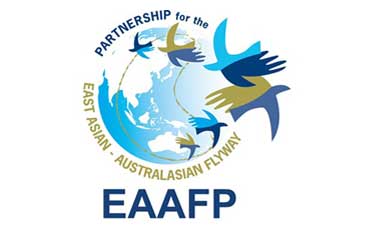-
Regional Dialogue on the Conservation Management of the Intertidal Wetlands of the Yellow and Bohai Seas
An International Symposium on the Conservation and Management of the Intertidal Wetlands of the Yellow and Bohai Seas was held in the city of Yancheng, Jiangsu Province, China, from 13 to 14 December 2017, organized by the International Union for Conservation of Nature (IUCN) and Eco-Forum Global (EFG), with support from EAAFP. The southern Jiangsu […]
Continue reading -
East Asian-Australasian Flyway Partnership Position Vacant – Communication Officer
The East Asian–Australasian Flyway Partnership (EAAFP), a 36-member, informal and voluntary initiative, is the major international framework established to enhance collaboration for the conservation of migratory waterbirds and their habitats along the East Asian-Australasian Flyway. More information can be found on the EAAFP website at www.eaaflyway.net. The EAAFP is served by a Secretariat established in 2009 […]
Continue reading -
Avian Influenza Update in East and Southeast Asia (January 2018)
Sophie von Dobschuetz, FAO FAO/EMPRES-AH is constantly monitoring the avian influenza situation worldwide and compiles information from multiple national and international sources as well as peer-reviewed scientific articles. Close collaboration with country and regional offices, the implementation of avian influenza field surveillance projects and networks of expertise like the OIE/FAO OFFLU provide access to timely information […]
Continue reading -
WMBD2017 Reports
Bangladesh | Cambodia | China | Indonesia | Republic of Korea | Mongolia | Myanmar | Philippines | Thailand | Vietnam | Bangladesh Event name: WMBD Bangladesh Organizer: Nature Conservation Society Summary: In Bangladesh, World Migratory Bird Day 2017 was celebrated in a colorful way. The main event was conducted in Moulovibazar. On the 9th of May an art competition […]
Continue reading -
Welcome (back) Hyeseon !
Spike Millington We are very happy to welcome Ms. Hyeseon Do as new EAAFP Program Officer, replacing Ms. Minseon Kim, who is studying for a Master’s degree at the University of Cambridge, UK. Ms. Do was selected from a very strong group of applicants for this position, reflecting the high profile of EAAFP as an […]
Continue reading -
Knots Drawing Competition 2017
The 2017 Knots Drawing Competition celebrates the life of Knots to raise awareness of Red Knots and Great Knots. The theme is “The Future of the Knots,” to inspire viewers about Knots and their life, their future with people, and call for conservation of the Knots. There were 94 entries in the competition and 15 […]
Continue reading -
Secretariat
EAAF Partnership Secretariat3F Bon-dong G-Tower, 175 Art center-daero,Yeonsu-gu, Incheon, Republic of Korea (22004)Fax: +82 32 458 6508Phone: +82 32 458 6501 / +82 32 458 6502~4secretariat@eaaflyway.netEAAFP Science UnitRoom 506, Scientific Research Building,Beijing Forestry University, Beijing, China (100083)EAAFP FoundationPhone: +82 458 6507foundation@eaaflyway.net Chief Executive +82 32 458 6509 chief@eaaflyway.net Deputy Chief Executive +82 32 458 6500 […]
Continue reading -
EAAFP Publications
For the information on specific species, you can also refer to the pages under ‘Migratory Waterbirds’and ‘OUR ACTIVITIES – Working Groups/Task Forces’
Continue reading -
To Our Winged Travellers
About the project https://www.youtube.com/watch?v=b_kY954r5WE Video Your message will be delivered to the countries in East Asian-Australasian Flyway! ‘To Our Winged Travellers‘ is an interactive art project to celebrate the annual migration of migratory waterbirds. Since last May, over 1000 people participated in the project via online and at the local bird events in the East […]
Continue reading -
Year of the Knots 2017-2018
Year of the Knots logo © Janet Essley / EAAFP Red Knots and Great Knots are small, stocky wading birds. They use large, muddy estuaries around the coast for feeding. The population of both species has been declining at a rate of 2-2.5 % per year in recent decades, primarily as a result of habitat […]
Continue reading


